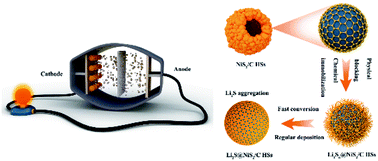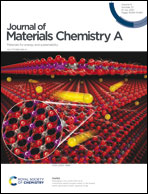Metal–organic framework derived NiS2 hollow spheres as multifunctional reactors for synergistic regulation of polysulfide confinement and redox conversion†
Abstract
The shuttle effect and sluggish redox kinetics of polysulfides seriously hinder the potential application of lithium–sulfur (Li–S) batteries. Herein, distinctive hollow structures of NiS2 (NiS2/C HSs) are developed to establish a double barrier of physical and chemical adsorption to prevent the migration of polysulfides and effectively accelerate the conversion of sulfur, which are verified by both theoretical computations and experiments. Attributed to the unique morphology and superior electrocatalytic activity of NiS2/C HSs, batteries with NiS2/C HSs can deliver excellent performance with a reversible capacity of 634 mA h g−1 with 2.0 mg cm−2 sulfur loading after 1000 cycles at 1.0C, which corresponds to a slight capacity fading rate of 0.017% per cycle. This work offers a simple MOF-derived strategy for the synthesis of NiS2/C HSs, holding great promise in developing practical applications of Li–S batteries with high energy density.



 Please wait while we load your content...
Please wait while we load your content...